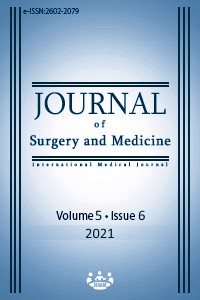Internal carotid artery agenesis and contralateral middle cerebral artery infarction
Keywords:
Internal carotid artery, Ischemic stroke, Agenesis, Magnetic resonance angiographyAbstract
Internal carotid artery agenesis is usually an asymptomatic condition. It is detected incidentally by radiological imaging performed for other reasons. It may rarely present with clinical manifestations such as subarachnoid hemorrhage associated with aneurysm, transient ischemic attack, or stroke. Agenesis can be erroneously interpreted as occlusion in case of insufficient clinical experience. The absence of the carotid canal on the bone window in the computed tomography scan of the brain helps confirm the diagnosis. The well-developed collateral circulation in patients with internal carotid artery agenesis is an effective factor in recovering from cerebrovascular diseases with less damage. Here, a rare case of agenesis of the right internal carotid artery and contralateral middle cerebral artery infarction is presented.
Downloads
References
Kunishio K, Yamamoto Y, Sunami N, Asari S. Agenesis of the left internal carotid artery, common carotid artery, and main trunk of the external carotid artery associated with multiple cerebral aneurysms. Surgical neurology. 1987;27(2):177-81. doi: 10.1016/0090-3019(87)90292-8.
Cohen JE, Gomori JM, Leker RR. Internal carotid artery agenesis: diagnosis, clinical spectrum, associated conditions and its importance in the era of stroke interventions. Neurological research. 2010;32(10):1027-32. doi: 10.1179/016164110X12767786356273.
Alurkar A, Karanam LSP, Oak S, Kori S. Congenital absence of internal carotid artery with rare type of intercavernous anastamosis and ruptured cerebral aneurysm. Journal of clinical and diagnostic research:JCDR. 2016;10(4):TD03. doi: 10.7860/JCDR/2016/17797.7549.
Taşar M, Yetişer S, Taşar A, Uğurel Ş, Gönül E, Sağlam M. Congenital absence or hypoplasia of the carotid artery: radioclinical issues. American journal of otolaryngology. 2004;25(5):339-49. doi: 10.1016/j.amjoto.2004.04.008.
Ryan FH, Kline LB, Gomez C. Congenital Horner’s syndrome resulting from agenesis of the internal carotid artery. Ophthalmology. 2000;107(1):185-8. doi: 10.1016/S0161-6420(99)00006-8.
Damry N, Hanquinet S, Christophe C, Janssen F, Delatte P, Perlmutter N. Bilateral congenital absence of the internal carotid artery with a primitive transmaxillary arterial anastomosis. Pediatric radiology. 1994;24(3):200-3.
Farhat W, Ahdab R, Hosseini H. Congenital agenesis of internal carotid artery with ipsilateral Horner presenting as focal neurological symptoms. Vascular Health and Risk Management. 2011;7:37. doi: 10.2147/VHRM.S16642.
Given II CA, Huang-Hellinger F, Baker MD, Chepuri NB, Morris PP. Congenital absence of the internal carotid artery: case reports and review of the collateral circulation. American Journal of Neuroradiology. 2001;22(10):1953-9.
Kim GE, Cho YP, Lim SM. The anatomy of the circle of Willis as a predictive factor for intra-operative cerebral ischemia (shunt need) during carotid endarterectomy. Neurological research. 2002;24(3):237-40. doi: 10.1179/016164102101199846.
Moritz A, Koci G, Steinlechner B, Hölzenbein T, Nasel C, Grubhofer G, et al. Contralateral stroke during carotid endarterectomy due to abnormalities in the circle of Willis. Wiener klinische Wochenschrift. 2007;119(21):669-73.
Downloads
- 162 328
Published
Issue
Section
How to Cite
License
Copyright (c) 2021 Fatma Şimşek, Filiz Aktaş
This work is licensed under a Creative Commons Attribution-NonCommercial-NoDerivatives 4.0 International License.
















